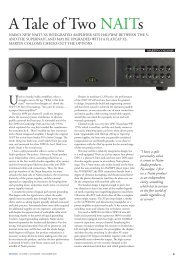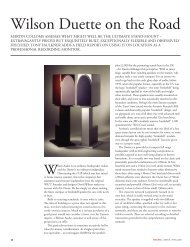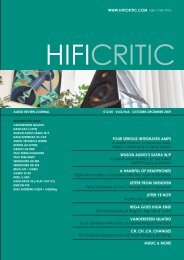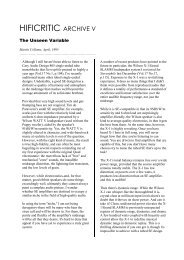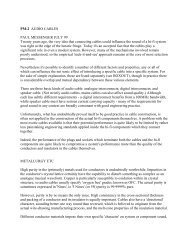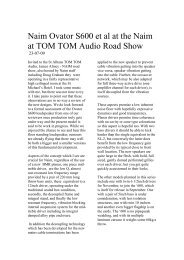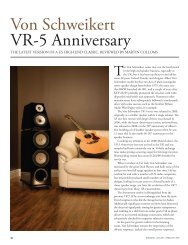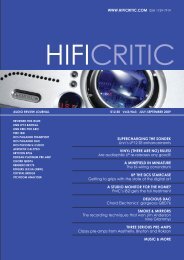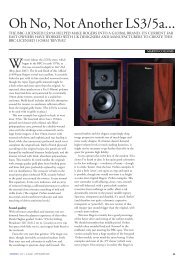HFC_issue4 8.indd - Hificritic.com
HFC_issue4 8.indd - Hificritic.com
HFC_issue4 8.indd - Hificritic.com
You also want an ePaper? Increase the reach of your titles
YUMPU automatically turns print PDFs into web optimized ePapers that Google loves.
Transporter of Delight<br />
SLIMDEVICES (NOW A LOGITECH COMPANY) CLAIMS ITS TRANSPORTER IS AN AUDIOPHILE<br />
SOLUTION FOR INTERFACING COMPUTERS WITH HI-FI SYSTEMS.<br />
MALCOLM STEWARD CHECKS OUT THE ERGONOMICS AND PERFORMANCE<br />
Having, it seems, been appointed Captain of the<br />
good ship CRSD (Computer-Related Stereo<br />
Devices), the second port of call on my cruise<br />
through the waters of networkable music boxes turned<br />
out to be Slimdevices Transporter (around £1,300 in<br />
the UK). This sleek black (or silver) network music<br />
player promises to: “Let you play your digitized music<br />
collection through your stereo system using your wireless<br />
or Ethernet network.” In plain English, this means that it’s<br />
fundamentally a box that you plug in to your pre-amplifier,<br />
which then grabs digitised music off your <strong>com</strong>puter.<br />
Well, that’s half the story, anyway. The Transporter relies<br />
upon a neat piece of software – the open source SlimServer<br />
– loaded on that <strong>com</strong>puter to organise and deliver the<br />
digitised music to it. Furthermore, the Transporter can be<br />
used as a standalone DAC, and will also deliver internet<br />
services such as radio and podcasts to your hi-fi. Both the<br />
device and its software look to be extraordinarily, in a word,<br />
neat: and they proved to be equally attractive once I had<br />
them connected to my systems – both hi-fi and <strong>com</strong>puter.<br />
The highly capable software is noteworthy for its slick<br />
operation, minimal footprint and the minimal impact it<br />
has on the <strong>com</strong>puter’s resources, although some of the<br />
skins supplied with it were, I thought, far less decorative<br />
and easy-on-the-eye than the basic default schema.<br />
(Unfortunately, aesthetics don’t seem to be a forte of the<br />
on-screen <strong>com</strong>munity.)<br />
Set-up problems were, for once, minimal and quickly<br />
sorted, which made a wel<strong>com</strong>e change from the phone calls<br />
to technical support and internet searches I’ve previously<br />
encountered with such devices. For example, hooking the<br />
Transporter into my <strong>com</strong>puter network was essentially neartrouble-free,<br />
using both Ethernet and wireless connections:<br />
the only glitch was that the device couldn’t locate my<br />
network’s internet gateway address, even though it managed<br />
to locate my DNS server, DHCP server, and the shared<br />
directory on my desktop that holds my music collection<br />
without any problems. A few button-pushes on the remote<br />
control told the device that I wanted to configure it<br />
manually, inserting the correct IP address for the gateway<br />
instead of the default address it had assumed to be correct,<br />
and all was working – literally – within five minutes. When<br />
I switched from an Ethernet connection to my wireless<br />
network, the process was relatively plain sailing, which was<br />
a surprise given the technical and security hoops that most<br />
visitors have to jump through to allow their laptops to gain<br />
access to my network and the internet.<br />
Primarily, I suppose, that’s because the Transporter is not<br />
a storage device, and since all that aspect of its operation<br />
is taken care of by the user’s <strong>com</strong>puter, there’s no need to<br />
have a display of any type in the listening room. It is driven<br />
by a remote control, or its fascia buttons, in league with<br />
a pair of front panel 640 x 32 pixel fluorescent display<br />
elements. These are thoughtfully designed, informative,<br />
and quite entertaining if you enjoy ‘dancing’ displays, and<br />
the programming behind them means that they operate<br />
logically and consistently – at least they do as far as I’m<br />
concerned, which represents a major step forward in GUI<br />
(graphic user interface) design!<br />
Appearing very early in the Owner’s Guide are the<br />
following potentially contentious sentences: “Transporter<br />
was designed to appeal to the most discerning audiophiles<br />
4<br />
HIFICRITIC JULY / AUGUST 2007




